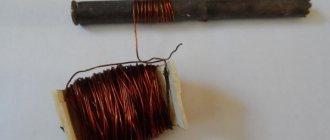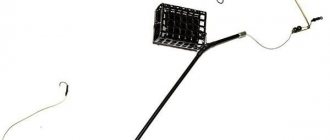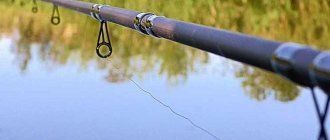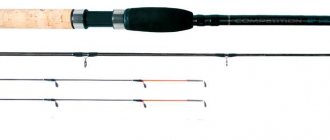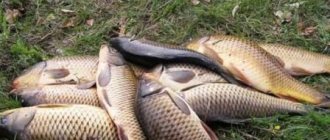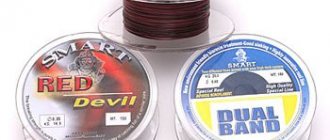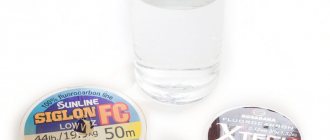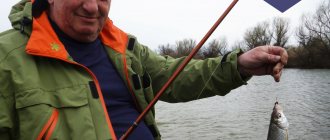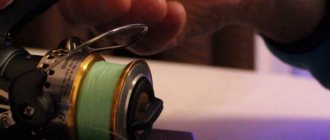In what equipment are fishing beads used?
2.1. The role of beads in float equipment
The most popular type of rig that uses beads is the float rig. When making such an installation, a variety of additional elements are used (beads, carabiners, knotless hooks, swivels, locking knots). It is impossible to do without these assistants, since they are not only an integral part of the equipment, but also ensure the safety of all structural elements.
Fishing beads are involved in the design of a sliding float, where their main function is to limit the depth of descent of the bait and unhindered passage through the rod rings. These small balls are located between the float and the stop knot, where they slide freely along the fishing line.
All the most important things about a sliding float: characteristics, shapes, types of fastening, conditions of use, selection rules for long casting and much more, read here
2.2. The role of beads in feeder montages
Rubber beads are also used in various rigs in feeder fishing. For example, in an installation using anti-twist tubes, two beads located at different ends of the fishing line after the tubes act as stoppers. The role of clamps is also assigned in such installations as “in-line” with a feeder.
For correct installation with a tap on a bead, see the Zamyatin Club channel
If you are interested in the topic of fishing stoppers, then this is the place for you
2.3. Beads in spinning rigs
2.3.1. Using beads in Texas rigging
The use of beads in the “Texas rig” is also justified. This type of equipment consists of a fishing line, an offset machine with a silicone worm, and a sliding bullet weight. A bead is placed between the offset hook and the bullet. In this case, the bead is not the main element of the equipment, however, thanks to the noise effect created by tapping the bead on the weight, the prey begins to be interested in the bait.
2.3.2. The use of beads in the Carolina rig
In the “Carolina rig” installation, the bead is a mandatory accessory, as it protects the fishing knot that connects the leash to the cord from the impact of the load so that it does not break. Additionally, just like in the Texas rig, the bead creates a noise attraction for prey by tapping on the sinker.
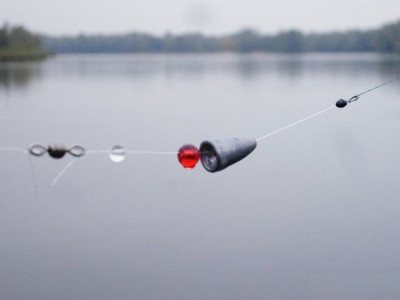
2.3.3. The use of beads in equipment when fishing with bombarda (sbirulino)
In this installation, one rubber bead plays the role of a retainer, that is, a fishing stopper, which is strung on the main fishing line in order to limit the movement of the float (bombard) towards the tackle. The second bead acts as a shock absorber, protecting the fishing swivel from being struck by the float when casting the equipment, thereby increasing the life of the attachment point.
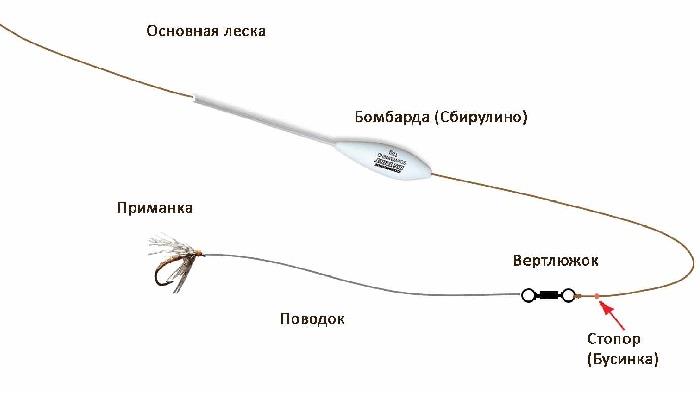
2.4. Beads in sea bottom montage
Paternoster is a rig with side fishing leashes, common among anglers who are keen on sea bottom fishing in plumb and freshwater feeder fishing.

In this type of equipment, beads secured between crimp tubes secure the swivel to which the fishing leash is attached.
The diverter leads are fastened using beads with a special cross-shaped hole, the name of which is “cross bead” or “2 way bead” (the name is used less frequently). Sea fishing, just like freshwater fishing, is based on the development and selection of a specific installation for specific conditions; beads with a cross-shaped hole for finding the most catchy equipment are very suitable, since the installation of fishing diverter leashes with beads allows us to make universal bases for the paternoster.
This is what a cross bead looks like
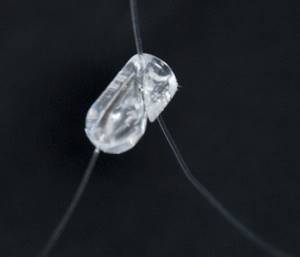
The main thing in fastening fishing beads is their free rotation on the fishing line. Here you should pay attention to the size, which can be as follows: large (large), medium (average), small (small). The diameter of the holes themselves is determined at random, since the manufacturer does not mention it in the description. The main thing here is that the leash passes through the thread of the bead more tightly, then the knot securing the leash will hold it more reliably.
2.5. Beads in a carp montage
Beads in a carp “helicopter” montage
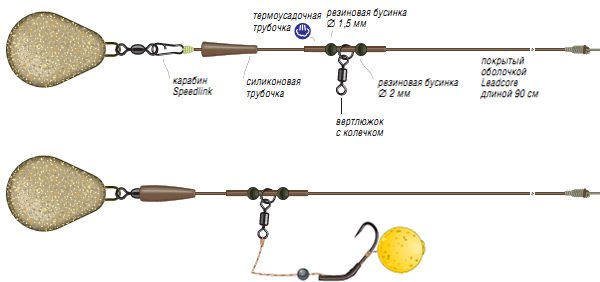
Carp installation for float tackle
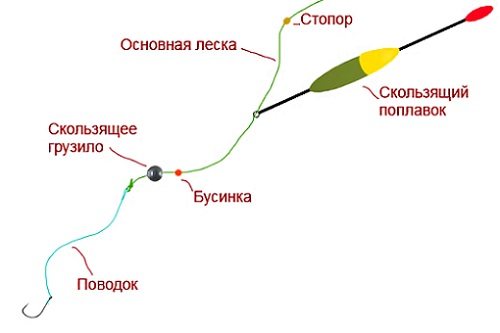
Types of stoppers
The following are used as a line stopper in various equipment options: a silicone stopper, a bead, a cambric, or a knot.
Silicone
Factory-made silicone stoppers for fishing line have the shape of an ellipse or a ball; for convenience, they have a loop that allows you to pull it and put it on the main fishing line.
Industrial stoppers have a size designed for a certain thickness (diameter) of fishing line. The requirements for a silicone stopper are as follows:
- Good density.
- Elasticity.
- From a reliable manufacturer - stoppers made by someone unknown may disappoint you. They will not have the required characteristics and will not fit the selected fishing line diameter.
Cambric
This group also includes plastic cambrics, which are sold in stores, and a piece of simple elastic (nipple). Nipple stoppers have been used for a long time, but have a number of disadvantages. For example, they slip off the fishing line.
Thread
This factory-made stopper is formed from thread and is sold complete with beads. You can fix it and put it on the fishing line using a plastic tube through which the fishing line is inserted. After tightening such a knot, the ends of the thread should not be completely cut off, leaving a little.
Stopper knot
It is knitted directly onto the fishing line. If you are tying such knots for match fishing, keep in mind that they must pass freely through the passage rings.
Basic requirements for such knots: must be well tightened.
You can knit stopper knots from any fishing line, but preference is given to braided or thick woolen thread. On a monofilament fishing line, braided knots will be more reliable and will also be better visible.
Here are examples of stop knots:
Material for making fishing beads
Fishing beads are made from various types of materials: silicone, glass, ceramics, plastic, etc. The use of beads made of a specific material depends on the type of fishing. For example, in installation with a sliding float, ceramic beads are used, which do not have sharp edges and are quite heavy, which can be very important.
Beads made of plastic and glass are used by fishermen for fishing with jigs, however, for example, plastic fishing beads have a disadvantage because they are light in weight, which causes them to stick on the fishing thread, slip through the rings of the tackle, which can lead to breakage of the equipment. Glass beads tend to break. Also, round pieces of glass cannot be quickly changed at the time of fishing, since they are put on the shank of the fishing hook before preparing the jig tackle.
Are you interested in the structure of a fishing float, its characteristics and want to know how the elements of the float affect the fishing process? - then read this article
"Palomar": how to knit?
It was said above that it is easy to perform, so the progress of its implementation will be remembered quickly. The following steps will connect the elements of fishing equipment with a Palomar loop:
- You need to fold the fishing line in half to make a loop.
- We pull the resulting loop into the eye of the hook or bait. If this cannot be done due to a small hole, then you can simplify it. We direct the end of the fishing line into it. Having formed a loop, pull the end of the fishing line through the eye in the opposite direction.
- Then we tie the hook ring with a fishing line folded in half with a regular knot. The hook was inside the fishing line.
- You need to wrap the end of the loop over the shank of the hook.
- Take the hook in your right hand, and both ends of the fishing line in your left hand and pull them. Trim the end leaving 3mm. Using a palomar knot, you tie the hook to the fishing line.
Using beads as bait
In winter, during a period of low fish activity, jig fishing can be not only exciting, but also original. Thus, several small beads attached to a fishing thread at a certain distance can arouse the interest of future prey.
How it works? It's simple. The beads are attached to a fishing line, for example, for catching perch, at a distance of no more than 30 cm from each other, forming a kind of colored garland. When you throw the “garland” into the water, it begins to move smoothly, reminiscent of natural bait. You need to play with the tackle from the bottom to the top of the hole. The game takes place in a vertical position. To achieve the best result, you can tie a loop in the places where the bead is attached, onto which you attach a bloodworm.
What is the advantage of this type of artificial bait like a bead? Firstly, the color and size variety of beads. Secondly, it's cheap. Thirdly, durability of use.
A common disadvantage of beads used directly as bait is the difficulty in selecting the desired combination of catchable colors for specific fishing conditions. To do this, the fisherman needs to have several jigs in stock or spend his time selecting the right combination, and this is very problematic to do on a persistent frosty day.
7.1. What are the requirements for beads attached to a jig?
The attachment made from artificial beads must be ideal and meet the following requirements:
- strength to withstand catching more than one fish;
- ease of replacing beads;
- ideality in a round shape, which would not twist the fishing line when quickly reeling it out of the water or idle hooking;
- variety of sizes and colors;
- naturalness, that is, to be as close as possible to the inhabitants of the reservoir;
- be silicone.
7.2. How to make silicone beads with your own hands
To make the perfect bait beads, you need to stock up on some types of silicone baits, for example, vibrating tails and twisters of various colors.
What else will you need for production:
- sewing needle;
- cold water (1 glass is enough);
- gas stove.
Manufacturing instructions:
- Cut the silicone baits so that you get cubes ranging in size from 1 to 4 mm. This size will determine the size of the bead in the future.
- Then prick the cube onto the needle in the center so that the tiny tip of the needle peeks out.
- Place a glass of water near the gas burner.
- Take a needle with a cube and bring it to the fire.
- Rotate the cube evenly (like a kebab) over the fire.
- After the cube has acquired the desired shape, it should be immersed in cold water, so it will cool and harden.
- The nozzle is ready.
7.3. How to attach beads to a jig
Evgeniy will tell you in detail how to attach a bead to a jig.
7.4. How to attach beads to fishing line
The most optimal and reliable way to tie a bead is considered to be a method in which the fishing line is passed through the central hole in the bead twice and secured with a double knot. With this method, firstly, the direction of the fishing line is maintained and secondly, the reliability of the connection is ensured.
useful links
https://mas-te.ru/sovetyi-masteru/biser-v-pomoshh-ryibolovu/ - an interesting article about fishing beads and seed beads;
https://seatackles.blogspot.com/2011/11/blog-post_23.html - article about paternoster - equipment for sea bottom fishing;
https://salapin.ru/articles/article758.html - an informative article about artificial baits;
https://housecomputer.ru/rest/fishing/books/entsiklopediya_sovremennoy_ryb/21_vmesto_zaklyu4eniya/2.html - about beads from the Encyclopedia of Modern Fishing.
